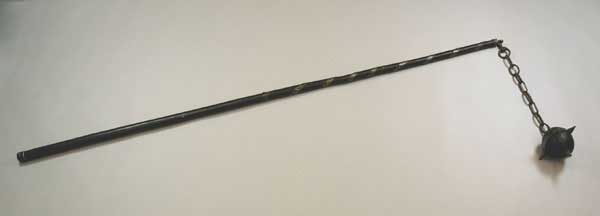Hinged
Contents
From the V8 Rulebook
- No more than 36” in length.
- Has a single articulating head which must be entirely Strike-Legal and cannot contain a rigid core.
- The chain of a hinged weapon:
- Is not a legal striking edge.
- Must be wrapped in foam with less than 0.5” of the rope exposed at any point.
- The combined rope and striking edge may not exceed 18” in length.
- The top half of the non-rope and Strike-Legal portion of the weapon must be padded.
About hinged weapons

The flail is a medieval weapon made of one (or more) weights attached to a handle with a hinge or chain. There is some disagreement over the names for this weapon; the terms "morning star", and even "mace" are variously applied, though these are used to describe other weapons, which are very different in usage from a weapon with a hinge or chain, commonly used in Europe from the 13th century to the 15th century. In construction, the morning star and flail have similar, if not identical, spiked heads. Thus, morning star is an acceptable name for this weapon, especially as the name "flail" is also used to describe a style of whip used for flagellation. The term "morning star" actually refers to the head of a weapon[citation needed] (the small round spiked ball) and can be used for either a morning star mace (on a shaft) or flail (if on a chain). Flails also sometimes had blunt round heads or flanges like a mace. Some written records point to small rings attached to chains on a flail used to inflict greater damage, but no historical examples are known to exist.
The martial flail began as a variant of the normal agricultural flail. The term "flail" was given first to a farming implement used to separate wheat from chaff. This was normally a block of wood attached to a handle with either leather or rope. It was probably farmers called up for military service or peasant rebels who discovered its usefulness as a weapon. A few added spikes made the flail even more dangerous. The Hussites fielded large numbers of peasant soldiers with flails.
Later, special military flails were made, such as the iconic short stick with the chain and spiked metal ball. A mace and chain is a type of infantry weapon, most commonly used during the Middle Ages. It consists of a mace or morning star, only with the handle replaced by a chain, which itself connects to a shorter handle. Soldiers using a mace and chain grasped this short handle with either one or two hands, and swung the weapon at the enemy in battle. Soldiers could swing the mace in a circle to gain momentum, before releasing it on the enemy. This would cause major damage to an enemy.
Combat charateristics
Unlike a sword or mace, it doesn't transfer vibrations from the impact to the wielder. This is a great advantage to a horseman, who can use his horse's speed to add momentum to an underarmed swing of the ball, but runs less of a risk of being unbalanced from his saddle.
It is difficult to block with a shield or parry with a weapon because it can curve over and around shields or armor.
The flail needs space to swing and can easily endanger the wielder's comrades.
Controlling the flail is much more difficult than rigid weapons.
If the flail was swung with enough force it could crack open plate armour and stun the wearer.
Culture
Many amtgard fighters and even entire parks view hinged weapons with disdain. A common adage holds that the word "Flail" means "Can't use Sword". This stems in part from the perception that using flails grants an unfair advantage vs. other weapons, making an otherwise mediocre fighter appear better than he or she is, along with the corollary that a fighter relying on flails for wins will cripple their long-term development by relying on them. It is not uncommon to see hinged excluded as a category in tournaments, relegating them to the "open" category, and even then if used they are often met with jeers and disapproval from the other participants.
In previous versions of the rulebook (prior to 7.0), the Pole Flail was legal, and these were even greater sources of derision and hatred from the serious fighting community.
A park that does not use any hinged weapons at all for these reasons is said to be "unhinged".
Jugging
One notable exception to the above is Jugging, where one of the positions, "chain", mandates the use of hinged weapons. There is generally no social stigma from using a flail in a jugging match.
Links
See Also: